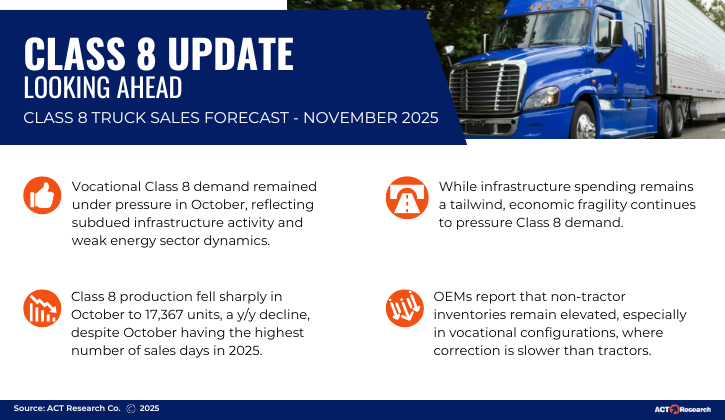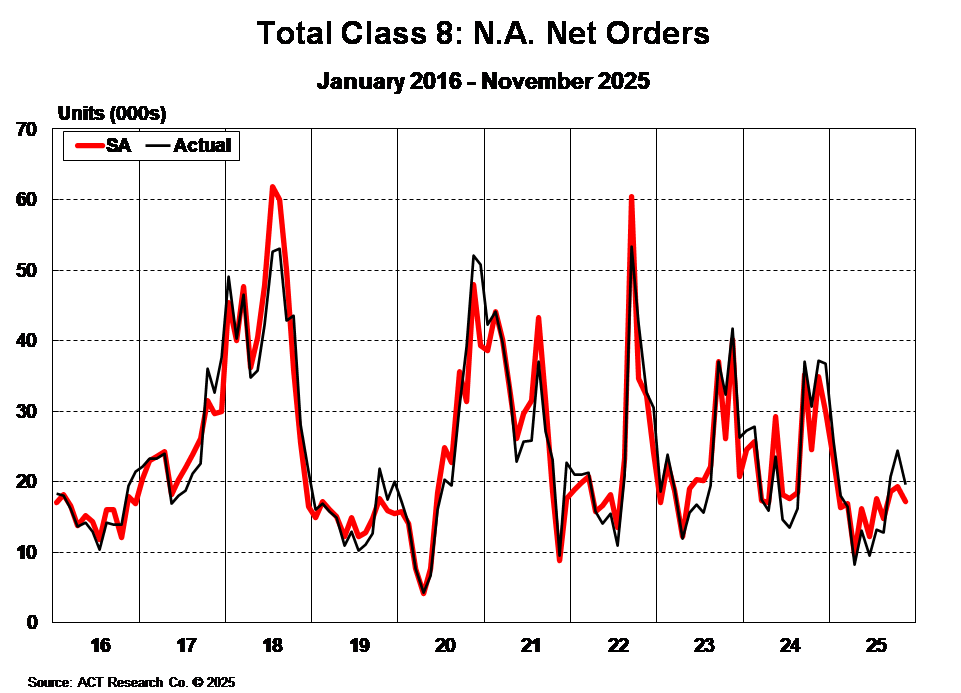
2025 Class 8 Truck Market
December 2025
Updated December 22, 2025
Infrastructure and Construction Support
Vocational Class 8 demand remained under pressure through November, reflecting subdued infrastructure execution, delayed project timelines, and continued weakness in energy-related activity. Vocational net orders remained down year-over-year, with softness in housing and nonresidential construction limiting upside. While utility and municipal replacement demand continues to provide a baseline of activity, momentum has slowed as public projects face permitting delays and higher input costs.
OEMs report that non-tractor inventories remain elevated, particularly in vocational configurations, where correction continues to lag tractors. While IIJA-funded infrastructure activity still provides a modest floor, industry feedback points to cautious dealer sentiment and restrained private fleet capex. Persistent cost inflation, tighter financing, and uneven project flow continue to stall more meaningful recovery across vocational and construction-oriented segments.
Production and Backlogs
Class 8 production remained constrained into November as OEMs continued to align output with weak order intake and margin protection goals. Build rates remain well below early-2025 levels, reflecting deliberate production discipline amid thin orderboards and recession-level carrier profitability.
Backlogs stabilized modestly, driven largely by reduced build rates rather than strengthening demand. The backlog-to-build (BL/BU) ratio remains historically low on a seasonally adjusted basis, signaling limited forward visibility. OEMs continue to manage backlog carefully, keeping 2026 orderboards light and production plans flexible.

Regulatory Shifts
Regulatory uncertainty remains a central headwind, though clarity improved late in the year. Indications from industry and ATA communications suggest EPA intends to retain the technology components of the 2027 low-NOx rule while removing or revising extended warranty and useful-life provisions. ACT’s base case now assumes partial rollback, reducing uncertainty but confirming higher equipment prices beginning in 2027.
At the same time, §232 tariffs on imported Class 8 trucks and components are now fully embedded in OEM pricing, materially increasing acquisition costs—particularly for Mexico-sourced or mixed-content vehicles. Combined with higher insurance, financing, and compliance costs, these pressures continue to suppress fleet order appetite and discourage discretionary purchases.
Capacity Rebalancing
The Class 8 market continues edging toward capacity normalization. Retail sales remain below replacement levels, accelerating contraction in the active tractor population. Tractor inventories are gradually correcting, while vocational inventories remain elevated and slower to normalize.
Used truck demand has softened alongside freight volumes, and resale values continued to decline through late 2025. Retail, auction, and wholesale prices all remain under pressure, underscoring lingering oversupply in secondary markets despite ongoing production cuts.
Moderate Growth in Orders
Total Class 8 orders remained weak through November, down sharply year-over-year during what is typically the strongest ordering period of the year. Carrier profitability remains deeply challenged, limiting fleet willingness to commit capital beyond essential replacement. Cancellations have remained relatively contained, suggesting fleets are largely sticking to existing plans rather than retrenching further.
OEMs continue to prioritize margin protection and backlog alignment over volume growth. Absent a clear inflection in freight demand or further policy relief, Class 8 demand is expected to hover near replacement levels into early 2026.
Economic Tailwinds and Risks
While infrastructure spending remains a longer-term tailwind, near-term economic fragility continues to pressure Class 8 demand. Freight-intensive sectors—including housing, manufacturing, and energy—remain soft, and trade-related disruptions continue to weigh on carrier profitability. Publicly traded truckload carriers reported another quarter of recession-level margins, reinforcing the need for conservative fleet strategies.
Smaller carriers remain particularly vulnerable amid tight credit conditions, elevated operating costs, and weak pricing power. Until freight fundamentals improve materially and regulatory risks subside, fleets remain focused on cost control, lifecycle extension, and liquidity preservation rather than expansion.
2025 Summary
The Class 8 truck market exits 2025 after a prolonged and unusually difficult downcycle marked by weak freight demand, elevated costs, tariff-driven uncertainty, and historically low profitability. While pre-tariff activity temporarily distorted volumes and pricing mid-year, those effects proved fleeting, leaving the industry to confront excess capacity and cautious fleet behavior. Importantly, 2025 also marked the start of a meaningful capacity contraction—driven by sub-replacement sales and disciplined OEM production—that sets the foundation for eventual recovery. However, that recovery remains contingent on sustained freight improvement and policy stability, positioning 2026 as a transition year rather than a full reset.
Jim Meil, Principal and Industry Analyst at ACT Research Co., shares his outlook on freight demand.

Want more data?
ACT’s commercial vehicle forecast delivers the most reliable, forward-looking insight into where Class 8 truck sales are headed—helping you anticipate shifts, plan with confidence, and stay ahead of the market.